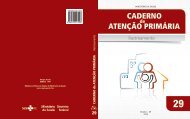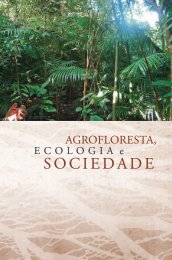Evolution of Oviductal Gestation in Amphibians
Evolution of Oviductal Gestation in Amphibians
Evolution of Oviductal Gestation in Amphibians
Create successful ePaper yourself
Turn your PDF publications into a flip-book with our unique Google optimized e-Paper software.
398<br />
Fig. 4. Male (16.0 SVL) and female (25.9 mm SVL) <strong>of</strong><br />
Nectophrynoides malcolmi.<br />
M.H. WAKE<br />
N. tornieri and N. uiuipara (Tornier, ’05) are ovovi-<br />
viparous and N. occidentalis is viviparous (Angel,<br />
’43; Angel and Lamotte, ’44, ’48); N. liberiensis is<br />
viviparous as well (Xavier, ’78). Wake (’80a) sum-<br />
marized new <strong>in</strong>formation and that from the litera-<br />
ture on egg size, clutch number, and features <strong>of</strong><br />
tadpole development <strong>in</strong> all <strong>of</strong> these species save N.<br />
liberiensis (Table 1). The “typical” bufonid, osgoodi,<br />
has a large clutch size for the genus at approximately<br />
300; the ova are 2.5-3.0 mm dia, and the tadpoles<br />
are free liv<strong>in</strong>g, with beaks, labial teeth a coiled gut,<br />
and a moderately large tail. The direct developer,<br />
malcolmi, has eggs <strong>of</strong> the same size as osgoodi, but<br />
a clutch <strong>of</strong> 11-31 (ii = 18). The tadpoles have a closed<br />
spiracle, lack beaks and labial teeth, have short guts<br />
and narrow tails. The two ovoviviparous species,<br />
tornieri (see Orton, ’49) and uiuipara, have simi-<br />
larly reduced tadpoles, fairly large, yolky eggs<br />
(3.0-4.0 mm dia), but vary <strong>in</strong> clutch size, tornieri<br />
hav<strong>in</strong>g a small clutch <strong>of</strong> 9-37, and uiuipara a clutch<br />
<strong>of</strong> 114-135. The viviparous species, occidentalis and<br />
liberiensis, have small ova (0.5-0.6 mm dia) and<br />
small clutches (4-35 and 6-24, respectively. The tad-<br />
poles <strong>of</strong> liberiensis are not described, but those <strong>of</strong><br />
occidentalis are similar to those <strong>of</strong> the ovovivipa-<br />
rous species, but they also have several rows <strong>of</strong> pa-<br />
pillae around their mouths; these are thought to<br />
be <strong>in</strong>volved <strong>in</strong> the <strong>in</strong>gestion <strong>of</strong> the maternal nutri-<br />
ent secretions, perhaps act<strong>in</strong>g as “sponges.”<br />
The mechanism <strong>of</strong> viviparity, if not its evolution,<br />
is best known <strong>in</strong> N. occidentalis <strong>of</strong> any amphibian.<br />
In a series <strong>of</strong> careful, detailed, and <strong>in</strong>formative pa-<br />
pers, Lamotte and Xavier and their colleagues re-<br />
ported on the development, endocr<strong>in</strong>ology, and<br />
ecology <strong>of</strong> viviparity <strong>in</strong> the species. They studied<br />
oogenesis, <strong>in</strong>clud<strong>in</strong>g corpora lutea development<br />
(Vilter and Lugand, ’59b), and other aspects <strong>of</strong> the<br />
morphology <strong>of</strong> the female reproductive cycle (La-<br />
motte and Rey, ’54; Lamotte et al., ’64; Xavier, ’73,<br />
’75a), the endocr<strong>in</strong>ology <strong>of</strong> the system (Xavier, ’70a,b,<br />
’74; Xavier et al., ’70; Xavier and Ozon, ’71; Zuber-<br />
Vogeli, ’68; Zuber-Vogeli and Doerr-Schott, ’76;<br />
Zuber-Vogeli and Xavier, ’72, ’73), <strong>in</strong>tra-oviductal<br />
tadpole development (Lamotte and Xavier, ’72; Xa-<br />
vier, ’75b; Vilter and Lugand, ’59a), and ecology<br />
(Lamotte, ’59; Xavier, ’75a). This work was sum-<br />
marized and synthesized by Xavier <strong>in</strong> 1977 <strong>in</strong> a sem-<br />
<strong>in</strong>al paper, and aga<strong>in</strong> <strong>in</strong> 1986. Figure 5 illustrates<br />
the <strong>in</strong>teraction <strong>of</strong> ecology, morphology, endocr<strong>in</strong>ol-<br />
ogy and development <strong>in</strong> N. occidentalis. Dur<strong>in</strong>g the<br />
dry season on Mt. Nimba from October through<br />
April, the female frogs retreat underground. Ovu-<br />
lation and fertilization take place just before the<br />
frogs retreat. Dur<strong>in</strong>g the underground period, cor-<br />
pora lutea are active, secret<strong>in</strong>g progesterone which<br />
<strong>in</strong>hibits oocyte growth and slows growth <strong>of</strong> the em-<br />
bryos. Dur<strong>in</strong>g this part <strong>of</strong> the gestation period, the<br />
oviductal mucosa is secretory. The frogs emerge <strong>in</strong><br />
April, with the <strong>in</strong>ception <strong>of</strong> the ra<strong>in</strong>s. They move<br />
about and forage. With emergence, the corpora lutea<br />
beg<strong>in</strong> to degenerate, and this is complete by May.<br />
With decreased progesterone secretion, oocytes <strong>in</strong>-<br />
crease <strong>in</strong> size and the oviductal mucosa becomes<br />
hyperemic and very secretory (Fig. 6), largely <strong>of</strong> a<br />
mucopolysaccharide material that is <strong>in</strong>gested by the<br />
develop<strong>in</strong>g young. Parturition occurs <strong>in</strong> June, with<br />
the birth <strong>of</strong> 4-35 fully metamorphosed froglets, each<br />
approximately 7.5 mm snout-vent length and weigh-<br />
<strong>in</strong>g 45 mg. Most <strong>of</strong> the oviductal epithelium dies<br />
and exfoliates, then it regenerates. With progester-<br />
one levels dim<strong>in</strong>ished, the ovary enters a follicular<br />
phase, and oocytes mature and vitellogenesis takes<br />
place as estrogen titers rise. In early October, ovu-<br />
lation occurs, and the cycle beg<strong>in</strong>s aga<strong>in</strong>. The entire<br />
gestation period is 9 months, and for approximately<br />
the last two months, the fetuses are nourished by<br />
secretions from the oviductal epithelium. The fe-<br />
tuses have large numbers <strong>of</strong> papillae around their<br />
mouths, and it has been conjectured that these fa-<br />
cilitate <strong>in</strong>gestion <strong>of</strong> the nutritive secretions. N.<br />
occidentalis is clearly the most derived species <strong>in</strong><br />
the genus, with its reduced ovum size, hormonal<br />
mediation <strong>of</strong> pregnancy correlated with environ-<br />
mental conditions, maternal nutrition by oviduc-<br />
tal epithelial secretions, and the modifications <strong>of</strong><br />
the develop<strong>in</strong>g tadpoles for lack <strong>of</strong> a free-liv<strong>in</strong>g lar-<br />
val stage and for <strong>in</strong>gestion <strong>of</strong> the nutritive secre-<br />
tions. The two ovoviviparous species are modified<br />
similar to direct developers, largely <strong>in</strong>volv<strong>in</strong>g mod-






